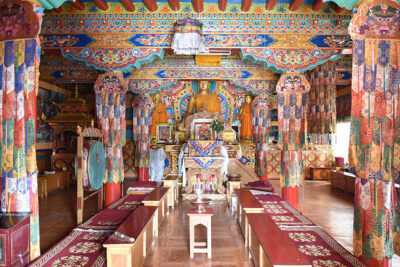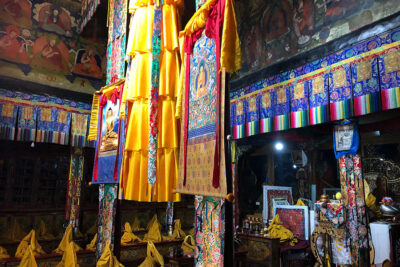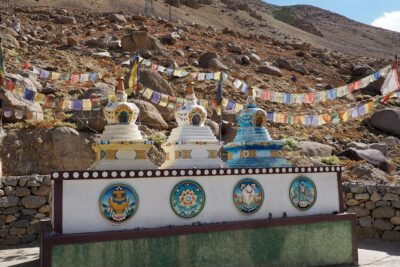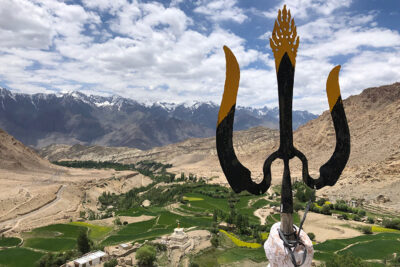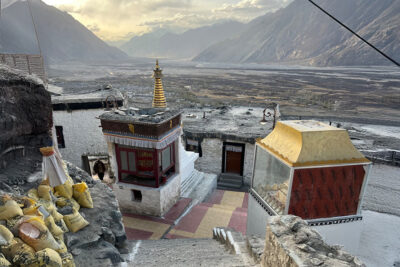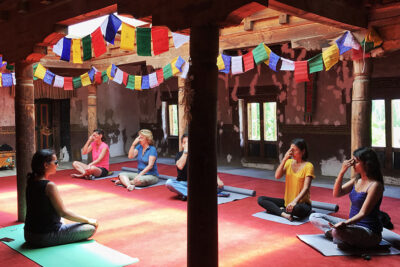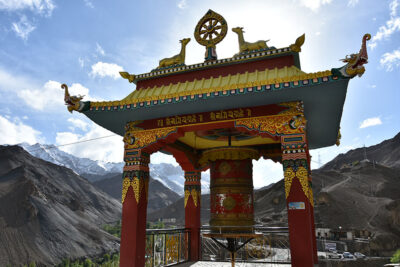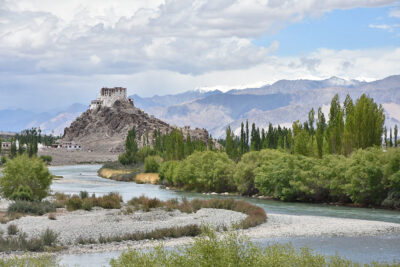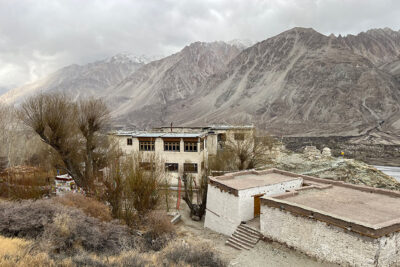Ladakh and Nubra Valley: a cultural experience
14 days
If you’ve ever dreamed of standing where desert meets snow-capped peaks, where ancient Buddhist chants echo through silent valleys, and where communities preserve traditions unchanged for centuries — this journey is for you.
We created this itinerary to take you beyond the ordinary, into the heart of Ladakh’s most authentic experiences. Over two weeks, you’ll discover why this raw, awe-inspiring land — often called Little Tibet — is unlike anywhere else. From colorful bazaars and royal palaces in Leh to windswept Himalayan passes and turquoise lakes at over 4,000 meters, every day brings something extraordinary.
You’ll witness monks’ morning prayers at Thiksey, explore the grandeur of Hemis Monastery, and visit Stok Palace’s private museum of thangkas and royal treasures. In Lamayuru, meet a community of Yogis and take part in the rare and ancient Chod ritual — a powerful moment of spiritual connection that few travelers get to experience.
This journey takes you off the beaten path: into the remote Dah and Hanu villages, where the Aryan community lives much as their ancestors did, and into Turtuk, a fascinating Balti village near the Line of Control. You’ll share traditional meals with local families, stroll through apricot orchards, and learn about farming, crafts, and a way of life rooted deeply in the land.
You’ll sleep in a tented Himalayan camp under a sky full of stars, wake up in quiet monasteries tucked into dramatic cliffs, and cross the legendary Khardung La — one of the world’s highest motorable passes. In Hunder, you’ll ride Bactrian camels over the Silk Road sand dunes, and later relax in Panamik’s natural hot springs while snow-capped peaks tower above you.
You’ll also marvel at the breathtaking sunset colours over Pangong Lake, walk through ancient murals in Alchi, and enjoy a hands-on cooking experience at the famous Alchi Kitchen. Every step brings encounters with Ladakh’s people — warm, resilient, and deeply connected to their traditions and faith — and moments of awe that only this remote corner of the Himalayas can offer.
This is not just a trip, but a journey through stories, landscapes, and cultures that will stay with you long after you return. Every detail is designed so you can slow down, connect, and experience Ladakh as few ever do — with authenticity, comfort, and memories to treasure for a lifetime.
JOURNEY OVERVIEW AND PROGRAM DETAILS
1° DAY: ARRIVAL AT DELHI
Delhi
Arrival at Delhi airport. Transfer to the hotel for some rest. Around 10am, after breakfast, guided tour of Old Delhi. In particular, the visit includes the Red Fort (visit from the outside only), a UNESCO World Heritage Site since 2007, built in 1639 by the Mughal emperor Shah Jahan (the creator of the Taj Mahal), the Jama Masjid, one of the largest of India, where an ancient copy of the Holy Quran written on deer skin is conserved. Visit the small back streets of this part of the city like Chawri Bazar which is one of the busiest streets in Old Delhi. Later, visit Raj Ghat, the cremation site of Mahatma Ghandi. After lunch you will visit New Delhi with its luxurious buildings, such as the India Gate, an arch erected in memory of the Indian soldiers who lost their lives fighting for the British army during the First World War, and the Parliament. In the late afternoon the tour will continue to the Gurudwara Bangla Sahib, one of the most important Sikh gurdwara, or Sikh house of worship in India, known as the “Sarovar”. Then transfer to the hotel.
Overnight in Delhi (B)
2° DAY: FLY TO LEH
Delhi – Leh
After an early breakfast, you are transferred to the domestic airport for your flight to Leh. This must be one of the most sensational flights in the world. On a clear day from one side of the aircraft can be seen in the distance the peaks of K2, Nanga Parbat, Gasherbrum and on the other side of the aircraft, so close that you feel you could reach out and touch it, is the Nun Kun massif. Upon arrival, transfer to the hotel. The rest of the day rest in the hotel premises to provide the necessary time to adjust to the altitude.
Overnight in Leh (B, L, D)
3° DAY: VISIT THE PALACE LEH
Leh
After breakfast, visit the TCV school, an integrated charitable organisation, which aims to ensure that all Tibetan children under its care receive a good education, a strong cultural identity and become self-sufficient and active members of the Tibetan community and the world. This is the only Tibetan school in Ladakh. Later transfer to Leh. Exploring the fascinating labyrinth of winding streets and picturesque local bazaars. The main street is open and airy, with rows of shops on both sides. Visit the spectacular Royal Palace of Leh, an amazing historical building that dominates the city; built in the 16th century, more or less in the same period as the Potala Palace in Lhasa (Tibet), which in fact has similar features. In the evening, walk to the Shanti Stupa to admire a beautiful sunset.
Overnight in Leh (B)
4° DAY: MONASTERY EXPLORATION THIKSHEY AND HEMIS
Leh
After breakfast, visit Thiksey and Hemis monasteries for morning prayer. Thikshey Monastery, perched on a rocky hill, resembles the Potala Palace in the Tibetan capital of Lhasa, famous for its distinctive architecture and location. Located on the top of a hill in the Indus Valley, the 12-floors monastery has 10 temples, assembly hall, rare and precious stupas, statues, thangkas, wall paintings and swords. It housed a large statue of Maitreya Buddha, whose purity of gaze invites reflection and silent meditation. Here you will participate in the morning prayer. Later, visit the Hemis monastery, the most famous and largest in Ladakh, belonging to the Drukpa order of Tibetan Buddhism. During the festival of the same name, which takes place every year in the monastery, you can witness at the Cham dance known as dance of the mystical mask. The monks wear flowing brocade costumes and brightly painted papier-mâché masks, depicting demons, and perform the chams or masked dance, representing the victory of good over evil. On the way back to Leh visit the Stok palace which houses a beautiful private museum. It will be a superb collection of thangkhas, which is said to be the best in the world.
Overnight in Leh. (B)
5° DAY: TRANSFER TO LAMAYURU
Leh – Lamayuru
After breakfast, drive to Lamayuru, a small village located about 2 hours from Leh, known for its ancient monastery and unique rock formations. The route takes you through mountain passes, river valleys, and remote villages, offering plenty of opportunities to see the typical landscapes of Ladakh. On arrival, visit the Lamayuru Monastery, one of the oldest in Ladakh, founded in the 11th century and a key center of the Drikung Kagyu school of Tibetan Buddhism. Built on a rocky hill, the monastery provides excellent views of the surrounding “moonland” terrain and houses several old temples, murals, and religious artifacts. Afterwards, visit the nearby meditation center, home to a small community of yogis who continue to practice traditional Tibetan tantric meditation. Here, you will have the chance to meet them, learn about their way of life, and witness the Chod ritual, a spiritual practice symbolizing detachment from the ego. Enjoy a traditional Ladakhi lunch at the meditation center, followed by free time to walk around the village and take in its quiet atmosphere.
Overnight in Lamayuru. (B, L, D)
6° DAY: VISIT TO DAH AND HANU VILLAGES
Lamayuru – Villaggio di Hanu
After breakfast, depart by road towards the Dah and Hanu villages, located approximately 2 hours’ drive from Lamayuru. These remote settlements are home to the Aryan community, a small ethnic group believed to have preserved its Indo-Aryan heritage and traditions over centuries.Upon arrival, you will spend the day exploring the villages, walking through narrow paths lined with apricot trees and stone houses. You will meet members of the Aryan community, known for their distinctive features, colorful traditional clothing, and deep pride in their ancestry. During the visit, you will have the opportunity to learn about their way of life, focused mainly on agriculture and livestock. The locals cultivate wheat, barley, and apricots, and raise goats, yaks, and sheep — an important part of their self-sufficient economy. Lunch will be served in the village: a traditional Aryan meal prepared with local ingredients. In the afternoon, you will have more time to interact with the families, discover their customs, and observe their craftsmanship and everyday activities. This is a unique chance to experience the culture of one of Ladakh’s most fascinating and little-known communities.
Overnight in homestay in the village (B, L, D)
7° DAY: TRANSFER TO ULEYTOKPO
Villaggio di Hanu – Uleytokpo
In the morning spend some time in the village with your host family, free time to stroll and to interact with locals enjoying their special hospitality. Traditional lunch with the community with local products. After lunch overland transfer to Uleytokpo (around 3 hrs). Check in a tented camp and enjoy the location. This is a special opportunity to live an extraordinary experience in a tent camp, surrounded by breathtaking landscapes of the Himalayan region between wide valleys, impressive mountain peaks and lunar landscapes. Free time to explore the surroundings, before your stay overnight in the tented camp.
Overnight in Uleytokpo (B, L, D)
8° DAY: VISIT ALCHI AND LIKIR MONASTRIES
Uleytokpo – Leh
In the morning visit Rizong monastry. Situated at the top of a rocky side valley on the north side of the Indus, to the west of Alchi on the way to Lamayuru. It was established in 1831 by Lama Tsultim Nima under the Gelukpa order, at Ri-rdzong. There are 40 monks in the monastery. The monastery is also called “the paradise for meditation” and is noted for its extremely strict rules and standards. After the visit, transfer for lunch at Alchi kitchen, to enjoy Ladakh’s traditional cuisine. Later visit the Alchi monastery. Founded in the 11th century by Rinchen Zangpo, the Great Translator, it was richly decorated by Kashmiri and Tibetan artists. This monastery is famous for its magnificent, very well-preserved wall paintings, dating back to the 11th or 12th century. The monastery is run by Likir monks and is no longer active as a place of worship. Last visit will be Likir Monastery, built in the 11th century and known for a 75 m high Buddha statue. The Likir monastery is one of the oldest monasteries in Ladakh and has many stories of its existence and origin. It offers panoramic views of the surreal landscape and the snowcapped Himalayan mountains. The natural beauty of the nearby surroundings attracts numerous visitors across the globe. While visiting this monastery, make sure that you also visit the small villages near the gompa as they offer amazing views for flawless photography. After the visit, transfer to Leh (around 1 hr) for overnight.
Overnight in Leh (B, L)
9° DAY: TRANSFER TO NUBRA VALLEY
Leh – Nubra Valley
After breakfast, depart from Leh for Nubra Valley, one of the most picturesque regions of Ladakh, known for its dramatic landscapes of sand dunes, rivers, and snow-capped peaks. The journey takes approximately 4–5 hours, crossing the famous Khardung La Pass (5,359 m), one of the highest motorable roads in the world. Along the way, stop to enjoy the breathtaking views and take photos of the surrounding Himalayan scenery.
On arrival in the valley, before heading to Hunder, stop to visit Diskit Monastery, the largest and oldest Buddhist monastery in Nubra. Here you can admire the impressive 32-meter-high statue of Maitreya Buddha, with spectacular panoramic views over the valley below. Continue to your accommodation in Hunder village, where you can take some time to relax. Later in the evening, experience a short camel safari on the unique sand dunes of Hunder, home to the double-humped Bactrian camels, a remnant of the ancient Silk Route trade caravans. This is a unique way to enjoy the surreal desert landscape surrounded by snow-clad mountains.
Overnight in Hunder (B, D)
10° DAY: VISIT TO TURTUK VILLAGE
Hunder – Turtuk – Hunder
After breakfast, depart towards Turtuk, a remote village on the edge of the Shyok Valley, just a few kilometres from the Line of Control. The two-hour drive takes you through breathtaking desert scenery and along the banks of the Shyok River. Upon arrival, you’ll discover one of the most fascinating cultural enclaves in Ladakh: Turtuk is home to the Balti people, an ethnic group with deep Indo-Tibetan roots and a unique way of life preserved over centuries. Accompanied by a local guide, you’ll explore the narrow lanes of the village, visit the modest royal house—now a small museum—and learn about the history of the region, once part of Baltistan before the borders shifted in 1971. You’ll have the opportunity to interact with villagers, sample locally grown apricots, and enjoy a traditional Balti lunch prepared by your hosts. In the afternoon, take a short walk to a small monastery overlooking the valley for panoramic views of the dramatic landscape before returning to Hunder by late afternoon.
Overnight in Hunder (B, L, D)
11° DAY: DISCOVERING SUMUR AND SURROUNDINGS
Hunder – Sumur
After breakfast, depart from Hunder for a short drive to the village of Sumur, located on the opposite bank of the Shyok River in the Nubra Valley. Upon arrival, check in at your accommodation and begin your day exploring this quiet, spiritual corner of Ladakh. The morning starts with a visit to Samstanling Monastery, an active and colorful Buddhist monastery nestled on a hill, surrounded by poplar trees and fields. Here you can observe the daily rituals of the monks and admire the vibrant murals depicting Buddhist deities and legends. After the monastery visit, take time to stroll through the surrounding sand dunes near Sumur, where the desert meets the high Himalayas. The unique landscape of rolling sand dunes framed by snow-capped peaks is one of Nubra Valley’s most iconic sights. In the afternoon, continue to Ensa Monastery, perched on a cliff with sweeping views over the valley. This quiet, less-visited monastery offers a sense of solitude and authenticity. You’ll then stop at Panamik Village, known for its natural hot springs. Here you can relax and experience a traditional hot-water soak, appreciated by locals for its therapeutic properties.
Return to your accommodation in Sumur for dinner and a restful evening.
Overnight in Sumur (B, L, D)
12° VISIT PANGONG LAKE
Sumur – Lago Pangong
After an early breakfast, depart by road for Pangong Lake, one of Ladakh’s most iconic destinations, situated at an altitude of over 4,200 meters. The drive takes approximately 6–7 hours through scenic valleys and high mountain passes, including a section along the beautiful Shayok River.
Upon arrival at the lake, enjoy the striking landscape of turquoise waters set against rugged mountains and wide open skies. Spend the afternoon walking along the shoreline, relaxing, and taking in the quiet and unique atmosphere of this high-altitude lake.
Later in the evening, take some time to enjoy the changing colors of the lake at sunset, a sight that makes this destination unforgettable. Dinner and overnight stay are included as part of the organized tour.
Overnight in Pangong (B, L, D)
13° RETURN TO LEH
Pangong – Leh
After breakfast, begin the return journey to Leh. The drive takes approximately 6–7 hours and follows a different route via Chang La Pass, one of the highest motorable passes in the world at over 5,300 meters. Along the way, enjoy one last look at Ladakh’s dramatic landscapes — wide valleys, rocky peaks, and small mountain villages.
Arrive in Leh by mid-to-late afternoon. After checking in, you’ll have some free time to rest or take a final stroll through the bazaar to pick up souvenirs or simply soak in the atmosphere of the town.
Dinner and overnight stay in Leh.
Overnight in Leh (B, L, D)
14° DAY: DEPART FROM LEH AIRPORT
After breakfast, transfer to Leh airport and depart for your international flight via Delhi.
activities
- Explore Delhi with its ancient neighbourhoods, colorful bazaars and iconic monuments,
- Experience the breathtaking flight over the Himalayas to reach Leh,
- Visit the Tibetan Children’s Village and the winding streets and bazaars of Leh,
- Visit the spectacular Leh Palace and admire a sunset from Shanti Stupa,
- Experience morning prayer with monks at Thiksey Monastery,
- Visit Hemis Monastery, the largest in Ladakh, and the royal museum of Stok Palace,
- Meet and interact with Yogis at Lamayuru and attend the Chod ritual,
- Spend one day in Dah and Hanu villages and meet the local Aryan community,
- Overnight in a homestay in Hanu and a tented camp in Uleytokpo, surrounded by Himalayan landscapes,
- Enjoy a Ladakhi cooking experience at Alchi Kitchen,
- Discover Alchi, Rizong and Likir Monasteries,
- Cross Khardung La Pass, one of the highest motorable roads in the world,
- Experience a camel safari on the sand dunes of Hunder,
- Visit the remote Turtuk village and discover the Balti culture,
- Relax in the hot springs of Panamik and walk among the sand dunes of Sumur,
- Enjoy the sunset over the turquoise waters of Pangong Lake.
SOCIAL AND ENVIRONMENTAL IMPACT
This itinerary has been thoughtfully designed to create meaningful connections with local communities, support the preservation of Ladakh’s unique cultural heritage, and raise awareness of the delicate balance between people and nature in the Himalayas. Throughout the journey, travelers are welcomed into remote villages — like Dah, Hanu, Turtuk and Panamik — where centuries-old traditions survive in harmony with the harsh environment.
By including an overnight stay in a traditional homestay in Hanu village, and sharing a home-cooked meal with your hosts, the trip directly supports local families in remote areas, providing economic opportunities that help preserve their homes, crafts, and farming lifestyle. Visits to Turtuk and Panamik contribute to the sustainability of these fragile communities, allowing travelers to learn about the unique Balti culture, the Aryan heritage of the Indus Valley, and local agricultural practices, while creating income that helps younger generations remain connected to their villages.
The monasteries visited — from Thiksey and Hemis to Lamayuru, Samstanling, Ensa, Rizong, Likir, and Diskit — are not only centers of spirituality but also vital cultural institutions for the region. Visitors’ presence and respect help maintain these sacred places and support the monks who preserve Ladakh’s Buddhist traditions. At Lamayuru, meeting with Yogis and witnessing the ancient Chod ritual is a rare opportunity to experience practices that are usually hidden from the outside world, while contributing to their continuity.
Traveling on routes less frequented — through the Nubra Valley’s desert and across its legendary passes — helps to spread tourism benefits more evenly and avoid overcrowding of popular sites. Staying in family-run accommodations, eating local produce, and hiring local guides and drivers all add to the positive impact of this journey.
This itinerary is a conscious alternative to conventional travel: it fosters cultural exchange, generates livelihoods in hard-to-reach areas, and allows you to see how deeply Ladakhis care for their land and heritage. In return, you bring home not just photographs but a profound sense of connection, and the satisfaction of knowing your journey has left a positive mark on the people and places you’ve encountered.
TIPS BEFORE DEPARTURES
A conscious approach to travel requires the ability and willingness to adapt to the local environment and culture. If you choose to travel with us, we ask you to be open to experiencing local traditions, religions, and ways of life without prejudice or pre-conceived notions that belong to our Western cultural perspective. Approaching this journey with patience and openness will allow you to access the true essence of the cultural heritage and spirituality of Ladakh, through the places you will visit and the people you will meet. If you are willing to make this effort, you will fully enjoy the beauty of Ladakh’s rich culture and religiosity, the extraordinary nature, and the solemnity of its Buddhist monasteries.
As a visitor to Ladakh, we ask you to respect the rights and beliefs of the local population and minimize your impact, both culturally and environmentally. Be aware of your actions and how they affect the people and environment around you. Here are some suggestions you should consider while visiting Ladakh: dress modestly — “more is better.” Revealing clothing is not appropriate, especially for women, but even men should avoid going shirtless. T-shirts and long trousers or skirts are recommended, while sleeveless tops, low-cut blouses, and shorts are not suitable — shoulders and legs should always be covered. Showing sensitivity to the local culture will also enhance your experience with the Ladakhi people. You’ll also avoid sunburn by covering up.
Please do not encourage begging — do not hand out pens, money, or sweets directly to children. This not only promotes begging but can also create conflicts between the children themselves. If you wish to make a donation, many local organizations can put it to better use. Rural schools are always happy to receive gifts of pens and distribute them appropriately among the children.
Leave nothing but footprints. Help keep unnecessary rubbish out of these magnificent mountains. Avoid buying drinks in plastic bottles, as there is no recycling available, and plastic is often burned, polluting the environment. Instead, bring your own water bottle and refill it with boiled, filtered, or treated water. And don’t forget to smile — easy to give, wonderful to receive, and it crosses all cultural boundaries.
This itinerary includes great opportunities for cultural exchange, adventure, and moderate trekking, but it is not suitable for everyone, as it involves some altitude and light trekking. When you arrive in Leh, remember you are at an altitude of 3,500 meters. Rest at your guesthouse on the first day, drink plenty of water — it’s a good excuse to read a book, relax, and take it easy. Listen to your body. This itinerary has been designed to minimize the effects of altitude as much as possible, with gradual acclimatization built in.
Altitude sickness can occur due to lack of oxygen at high elevations. If given time, your body will adjust. During the first few days, go slowly, drink a lot of water, carry only light loads, and pay attention to how you feel. Mild symptoms include headache, nausea, loss of appetite, mild shortness of breath, dizziness, fatigue, or difficulty sleeping. These are common at the beginning of the trip. However, in case of more severe symptoms — such as confusion, extreme breathlessness even at rest, or severe weakness — you must descend immediately, as these can be life-threatening.
We strongly recommend being vaccinated against rabies before traveling, as there are many stray dogs in Ladakh. Always be cautious when approaching dogs, especially at night in Leh.
This journey offers you an extraordinary experience in one of the most unique and spiritual corners of the Himalayas. With the right preparation and the right mindset, you will live an unforgettable adventure — and return home with memories, emotions, and encounters that will stay with you forever.
HOTELS
TYPE OF STAY: HERITAGE AND HOMESTAYS
For this journey we have selected accommodations that reflect the spirit of Ladakh — simple, authentic, and welcoming. In Leh and other main stops, you will stay in comfortable guesthouses offering clean rooms with private bathrooms (with hot and cold running water) and western toilets. In Dah and Hanu villages, you will experience an overnight stay in homestays hosted by local families, where the facilities are basic but the hospitality is warm and genuine — a unique way to immerse yourself in the daily life of the community.
TRANSPORT
Throughout the itinerary in Ladakh you will travel in private vehicles or air-conditioned mini-buses, depending on the size of the group, ensuring comfort even on the winding Himalayan roads. The internal flight from Delhi to Leh is included in the program.
WHEN TO GO
The best time to visit Ladakh is during the summer months, from late May to late September, when the weather is dry and pleasant, the skies are clear, and the high mountain passes are open — making it the ideal season to explore both the cultural and natural wonders of this extraordinary region.


